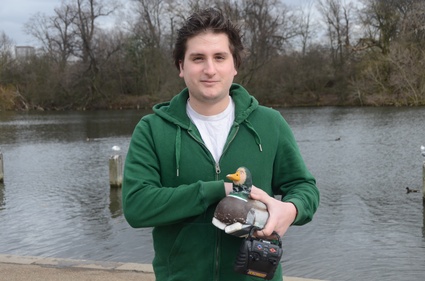
I think that the question i heard the most when i visited the work in progress show of the Design Interactions department at the RCA, London last month was “Have you seen Milan’s project?” The second most asked question was “Have you seen the duck project?”
My aim is to virtually live like a male Mallard duck in order to find friendship and who knows, maybe love, writes Milan Metthey. His self-assigned challenge to establish a personal connection with a duck is less absurd than it sounds. If a swan can fall in love with a plastic swan-shaped pedal boat, why wouldn’t a duck fall for a man?
Metthey’s project Love Ducking looks at how technology can help bridge the gap between human and non-human species. In his attempt to try and seduce a female Mallard duck, the designer tried to integrate the world of ducks.
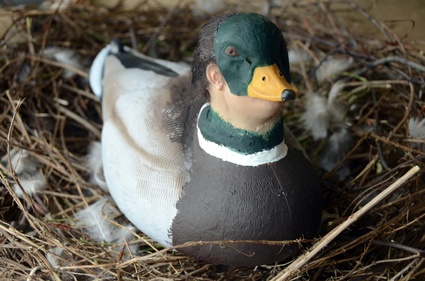
First, he scanned his face into a 3d modeling software and morphed the result with the head of a duck. A radio controlled duck was then fitted with the hybrid head and sent swimming among the ducks and recreate their mating ritual.
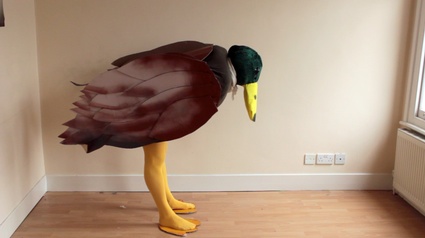
After that, the designer dressed like a duck, filmed the result and submitted a lady duck to a screening of the impersonification (not sure one can apply the word in this context but hopefully you’ll get my point.)
Since that wasn’t good enough to impress the duck, he invited it to a romantic dinner in his studio:
Love Ducking – Experiment 3, Romantic Diner
Extract from an email interview with the designer…
Hi Milan! What gave you the idea of trying to establish friendship with a duck? And why did you chose the duck? Why not a cat for example?
The initial idea came after thinking about the complexity of human relationships and how someone could want to break away from those. Technology allows us to be super-connected which dramatically increases the amount of communication between each other. We are constantly exposed to huge amounts of information from this ongoing process of updating ourselves, and that can become very quickly overwhelming.
So I wanted to break up from this flow, find a way to escape this complexity. The language and sign barrier present between animals and us seemed to be the perfect place to initiate new kinds of relationships.
The reason why I chose the Mallard duck is because I wanted to find an animal that is still perceived as wild, but who would also be living in cities. The cat has been living with us for thousands of years, they already have quite complex relationships with us; they have been completely assimilated in our human lifestyles. The relationship we have with some pets can already be quite complex, there are so many stories where the master is under the control of his pet and this is what I wanted to get away from. Therefore domesticated pets were simply not good enough candidates. And also, ducks are pretty darn funny animals to watch.
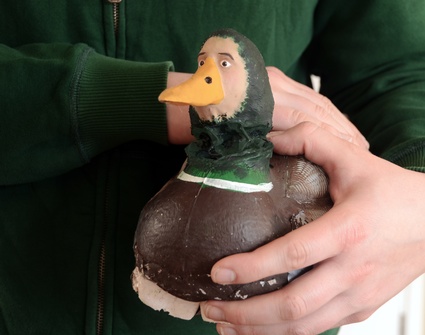
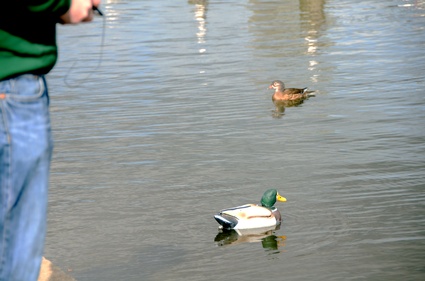 You documented 3 experiments so far. Was any of them more successful than the others? Are you planning on developing new strategies to establish friendship with them? Do you think that you’re progressing in any way?
You documented 3 experiments so far. Was any of them more successful than the others? Are you planning on developing new strategies to establish friendship with them? Do you think that you’re progressing in any way?
It’s pretty hard to tell accurately which one worked best because in the case of the Romantic Diner experiment, there was a magic element to trigger an interaction: food. The other ones were trying to test if the duck would recognize a specific movement or understand a 2D projection. Also ducks need a time of adaptation before they accept and welcome the robot-duck newcomer. So I would say that the flirt experiment with the radio controlled duck is the one I enjoyed most. And from what I saw, the costume projection is the one that the duck enjoyed most, she wasn’t cautious or distant about the object, she just hanged out there as usual.
In terms of new strategies, I am currently working on creating tools to enhance and facilitate cohabitation with the infamous urban Fox. I have been monitoring the foxes in my street for the past few weeks and I am just about to start implementing those tools and see what happens. It’s very exciting to see another species interact with things I’ve made, it’s very candid and naïve, but mind blowing at the same time.
I do go back to flirt with the ducks from time to time but in order to really see if there is a progress I should ideally leave my robot there all the time. Something I will certainly do when the next mating season starts in October/November.
Love Ducking – Experiment 2, Costume
How about you? Have you developed a stronger sense of affection? or just more respect for ducks?
You inevitably do get closer to the animal when you design for it. Spending so much time with the duck in mind does have a big impact. However I do force myself to keep the relationship I have with them strictly professional. I don’t want my feelings interfering with the project. I still eat duck from time to time even though now I take a different look at my plate. I guess it is a sort of curious respect, I respect the fact that they undergo my experiments although they don’t really have the choice. You do get to learn from other species when you analyse their lifestyles. The political systems are really fascinating to look at, because they are driven by nature itself, not brains.
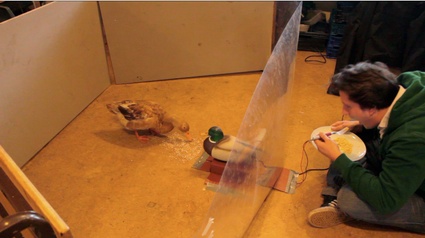 Did you pick up one in particular for your dinner? How did you select it?
Did you pick up one in particular for your dinner? How did you select it?
I did all my experiments in Surrey Docks Farm in London. It’s a wonderful place where they happen to have a duck pond in addition to all the usual farm animals. Barry Mason, the farm manager, kindly accepted to let me test my installations over there.
Ducks like to live in community so the staff had to pick up one duck that wouldn’t be too stressed when left alone with some strange projections and objects. The same female duck was used for the different experiments. We didn’t expect her to be so relaxed during the experiments, but it went really smoothly.
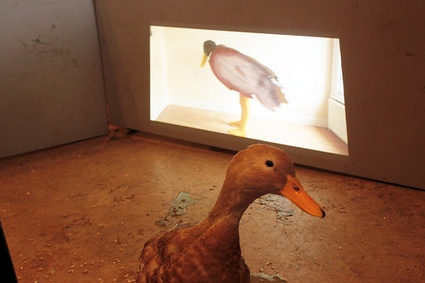 And do you feel you need technology to reach your goal?
And do you feel you need technology to reach your goal?
Yes, it was clear from the start that technology was going to be a big part of the project. I had to find ways to transform the human body shape into something that would be closer to a duck. In addition I absolutely had to bring in some motion to integrate a sense of “life” into my designs. Using electronics was the best tool to use for creating and simulating behaviours. I have also been using technologies such as 3D scanning and 3D printing to build unique duck heads that would then be fitted on my Radio Controlled duck. These kinds of tools allowed me to integrate my identity into my objects. But it is also important to keep some natural elements into the process. For example when I am impersonating a duck with my costume, I need to do it physically in order to have a true dialogue going on with the animal. When natural things are combined with technology, it creates some hybrid results that are very interesting. And seeing how nature reacts to it is even more astonishing.
Love Ducking – Experiment 1, Radio controlled duck
Have you consulted with any scientist or community of duck amateurs to develop the project? And if you did, did they encourage your experiments or did they suggest that was a bonker idea?
I have been in touch with many different people who are connected in various ways with the duck. When I started my research, I wanted to get opinions and views from everywhere. I started by watching hours of documentaries about ducks in order to have a basic knowledge of the animal and then I started getting in touch with various people linked to the duck in their everyday life. People like duck farmers, duck hunting shop owners and many various duck associations, both amateur and professional. I did a lot of research on youtube, this tool is exceptional for the casual aspect of my research. Of course it’s not the most valid tool for scientific facts but it really shows the human in all his splendor. The amount and diversity of videos you can find about people interacting with ducks is insane. It’s a very rich database that contains the worst as well as the best on pretty much any subject. An invaluable tool for me.
When I started contacting farms and duck owners to test my designs, I had mixed responses. Some of them simply refused to get their ducks involved into these experiments and saw no interest in doing such experiments. Others had doubts but were curious to see what the hell I was talking about. I think in the end it is all about the mindset of the person, exactly like a situation where parents are against having their kids going out and mix up with strangers. Surrey Docks City Farm manager Barry Mason was very keen to let me come and hang out with the ducks. As soon as I started setting up the experiments, even people who had doubts on the farm entered into the game and started being curious to see what would happen.
Where is the role of the designer in your experiments with ducks? I’m assuming it’s not in the wired cutlery.
My role here is to design the experience that the user will go through. I built these objects with the aim to give a quick and comprehensive feedback to the user when he is using these tools. The design importance here isn’t in the beauty of the object, it’s in the way it is going to be believed by the animal and in how you can control it in function of the ducks response. The other challenge was to find interesting and entertaining ways to communicate the story of a human seeking simpler relationships, tired of the human-to-human interactions. I chose iconic human tools and situations, then tried to put myself in the skin of a duck so that I could see from his perspective and adapt my design to a duck’s point of view. My job was then to combine this duck approach with our human habits.
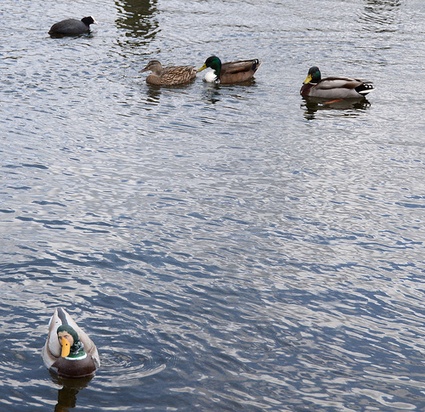 Thanks Milan!
Thanks Milan!
All images courtesy Milan Metthey.
